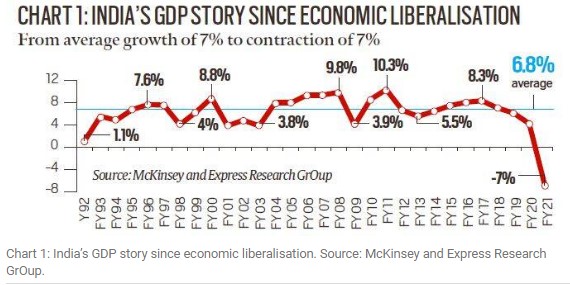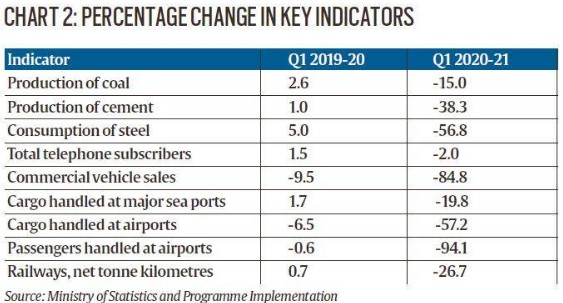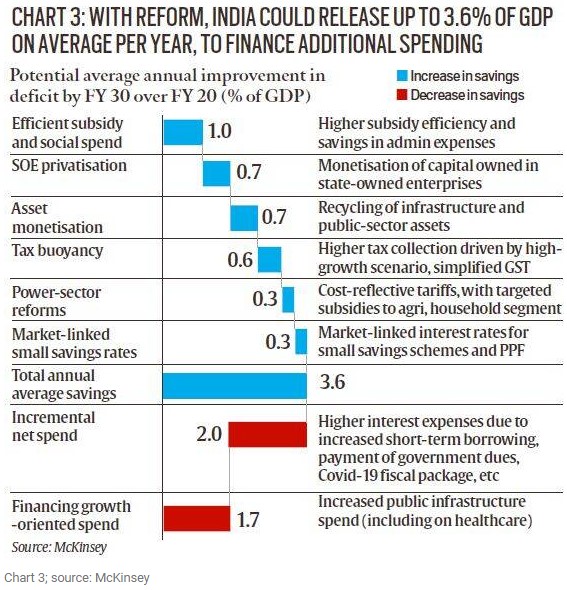Focus: GS-III Indian Economy
Introduction
- The collapse of gross domestic product (GDP) growth by 23.9% for the April to June period comes as an expectation given that the economy was under a strict lockdown for most of the time to contain the pandemic.
- Almost all the major indicators of growth in the economy — be it production of cement or consumption of steel — show deep contraction.
What does the GDP figure highlight?
- In Q1FY21, private consumption expenditure contracted by 26.7% and investment by 47.1%.
- With physical mobility limited, discretionary spending took a back seat, and the situation became worse as incomes fell.
- With migrant workers heading home, infrastructure projects were thrown out of gear, causing a huge contraction in investment.
- It should be noted that private consumption and investment are two major contributors to the GDP.
How did government expenditure fare?
- In recent years, government expenditure has formed 8-13% of the overall economy (the GDP).
- From April to June 2020, it reached at around 18.1% of the GDP, the highest in more than 19 years.
- This additional expenditure essentially ensured lower contraction of the economy.
- If we leave the government expenditure out of the calculation, what we are left with is the non-government part of the economy, which is the major part of the economy. This contracted by a massive 29.3%, much more than the overall economy.
What is biggest implication?
- With GDP contracting by more than what most observers expected, it is now believed that the full-year GDP could also worsen.
- Since economic liberalisation in the early 1990s, Indian economy has clocked an average of 7% GDP growth each year. This year, it is likely to turn turtle and contract by 7%.

- In terms of the gross value added (a proxy for production and incomes) by different sectors of the economy, data show that barring agriculture, where GVA grew by 3.4%, all other sectors of the economy saw their incomes fall.
How different Sectors fared?
- The worst affected were construction (–50%), trade, hotels and other services (–47%), manufacturing (–39%), and mining (–23%).
- It is important to note that these are the sectors that create the maximum new jobs in the country.
- In a scenario where each of these sectors is contracting so sharply — that is, their output and incomes are falling — it would lead to more and more people either losing jobs (decline in employment) or failing to get one (rise in unemployment).

What caused GDP contraction?
- In any economy, the total demand for goods and services — that is the GDP — is generated from one of the four engines of growth. The biggest engine is consumption demand from private individuals (In the Indian economy, this accounted for 56.4% of all GDP before this quarter).
- The second biggest engine is the demand generated by private sector businesses (This accounted for 32% of all GDP in India).
- The third engine is the demand for goods and services generated by the government (It accounted for 11% of India’s GDP).
- The last engine is the net demand on GDP after we subtract imports from India’s exports (In India’s case, it is the smallest engine and, since India typically imports more than it exports, its effect is negative on the GDP).
- So total GDP = C + I + G + N (Where C= Consumption from Private Individuals, I = Private Sector Businesses, G= Goods and Services Generated by the Government, and X= Net demand on GDP after we subtract imports from India’s exports).
In the Current Scenario:
- Private consumption — the biggest engine driving the Indian economy — has fallen by 27%.
- The second biggest engine — investments by businesses — has fallen even harder to half of what it was in the same quarter of 2019.
- So, the two biggest engines, which accounted for over 88% of Indian total GDP, Q1 saw a massive contraction.
The net result is that while, on paper, government expenditure’s share in the GDP has gone up from 11% to 18% yet the reality is that the overall GDP has declined by 24%.
It is the lower level of absolute GDP that is making the government look like a bigger engine of growth than what it is.
What is the way out?
- When incomes fall sharply, private individuals cut back consumption. When private consumption falls sharply, businesses stop investing.
- Since both of these are voluntary decisions, there is no way to force people to spend more and/or coerce businesses to invest more in the current scenario.
- The same logic holds for exports and imports as well.
- Under the circumstances, there is only one engine that can boost GDP and that is the government (G).
- Only when government spend more — either by building roads and bridges and paying salaries or by directly handing out money — can the economy revive in the short to medium term.
What is holding back the government from spending more?
- Even before the Covid crisis, government finances were overextended. In other words, it was not only borrowing but borrowing more than what it should have. As a result, today it doesn’t have as much money.
- It will have to think of some innovative solutions to generate resources.

-Source: Indian Express, Livemint



